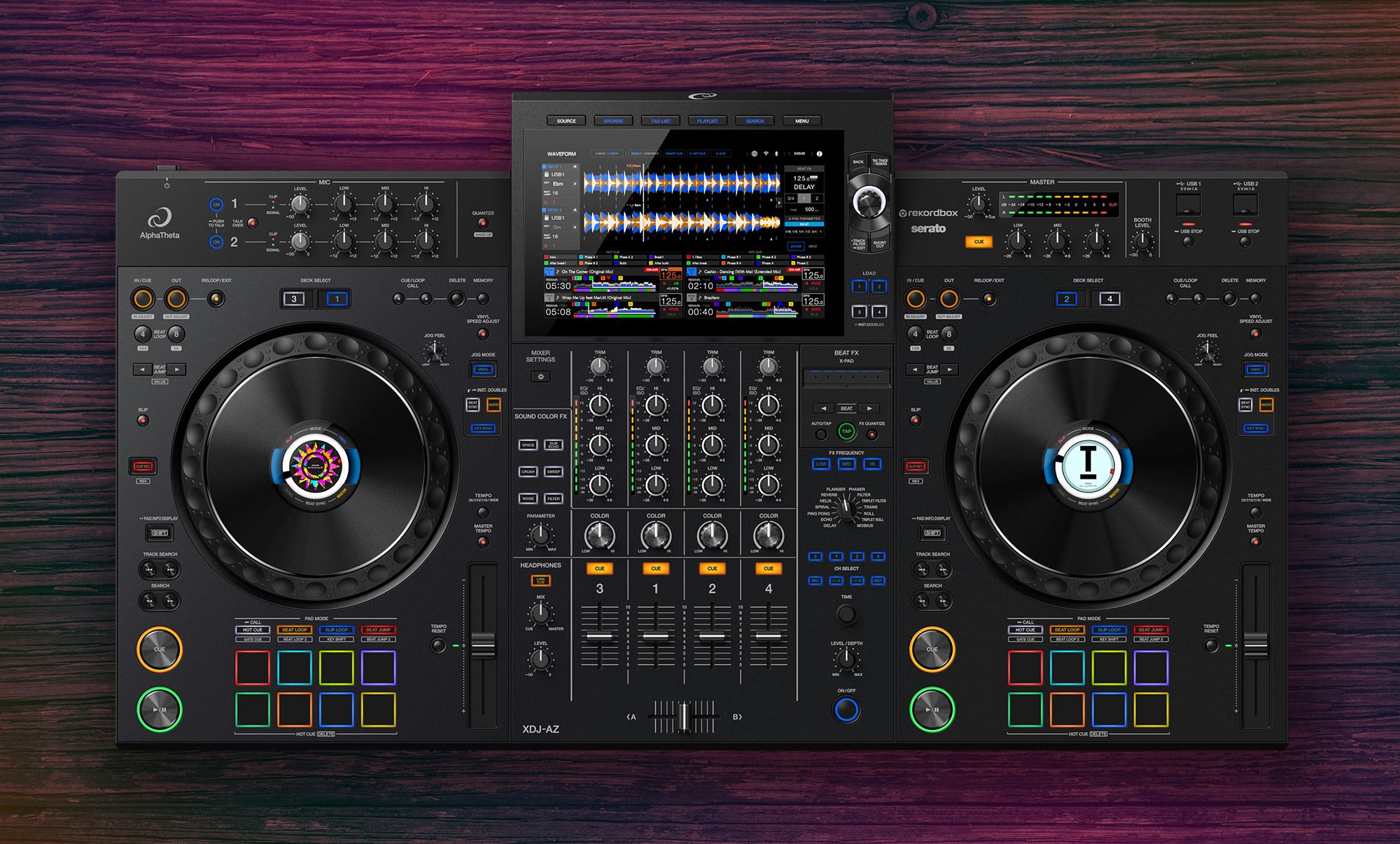Alphatheta just announced their XDJ-AZ – it’s an all-in-one standalone with four decks built into the unit. In this piece, I’ll share some of the details on the unit and offer a few first impressions and thoughts on how it is to mix on. In the world of digital DJ gear, standalone devices seem to be increasingly dominant, so I’ve also got a few thoughts on where the AZ fits into the busy landscape. Keep reading!
XDJ-AZ: the four decks that were promised
The XDJ-AZ has felt like Alphatheta/Pioneer DJ’s worst-kept-secret recently. I first saw rumors of the unit on Reddit about two months ago, confirmed by industry sources a few weeks later, and then got offered a unit for review about two weeks ago.
I’ve been craving four deck mixing in a XDJ-RX form factor for years. I was disappointed when the XDJ-XZ was announced and it was touted as “four decks!” but really was “four channels or pay for Rekordbox and bring your laptop with you!” The economics of Rekordbox and selling DJ hardware are intriguing (see “That Price Tho” section below), and it felt like Pioneer DJ would never compete with their own top-of-the-line gear.
Now, Alphatheta has delivered. Yes, they offered me a loaner unit to check out, but no, this isn’t a paid review. The opinions in this piece are my own. Yes, we will sell these in our store – support a small business with your preorder if you’re inclined:
Should you buy an XDJ-AZ?
I’ll keep my thoughts easy to parse at the outset so that short and to the point:
- If you’re looking for four-deck mixing on near-club-style gear in one package, this is it. It’s really fun to mix on, delivers on offering what’s needed, and I think it will become the dominant model of XDJ over the next few years.
- If you’ve bought a different standalone device recently: Want to be able to mix on three/four decks without anything else? I would recommend trying to sell your unit as used and upgrade. I expect that older models will retain their value well as many Pioneer DJ devices have over the years, but the best time to sell your old gear is always yesterday.
- If you don’t want to mix on more than two decks, the XDJ-AZ probably isn’t the right fit for you.
A lot of the great features on the AZ are simply keeping things that worked really well on the XDJ-XZ. There’s a reason why the XZ has so many fans, and the product designers clearly took notice of that in this release.
What’s Great On The XDJ-AZ
- Four decks, obviously. You can mix on them. They behave as you’d expect and feel reliable. The deck controls are “layer swap” style – so each side controls either 1/3 or 2/4. My two cents on four deck mixing: most DJs will find four decks excessive to mix on in a non-B2B situation, but almost every DJ can imagine why having a third deck makes sense for their mixing style.
- Wondering what you’d do with more than two decks? Give Ean’s classic “Mixing For The Stage” video a watch.
- Worth noting, the channels are labeled left to right: 3, 1, 2, 4. This is to keep 1 and 2 in the “middle” of the mixer and the primary decks, but it feels a bit weird to anyone used to setting up four CDJs and a mixer, where it’d usually be channel 1, 2, 3, 4.
- Everything matches the pro setup: The magic of the XDJ standalone line is that just about any aspiring club DJ sees the benefit: the workflow and muscle memory that you learn on the XDJs translates quickly to the CDJ setup. The AZ continues this trend by updating many of the controls to match the CDJ-3000, including looping, beat jump, key sync, and the workflow of the user interface and browse knob directly next to it.
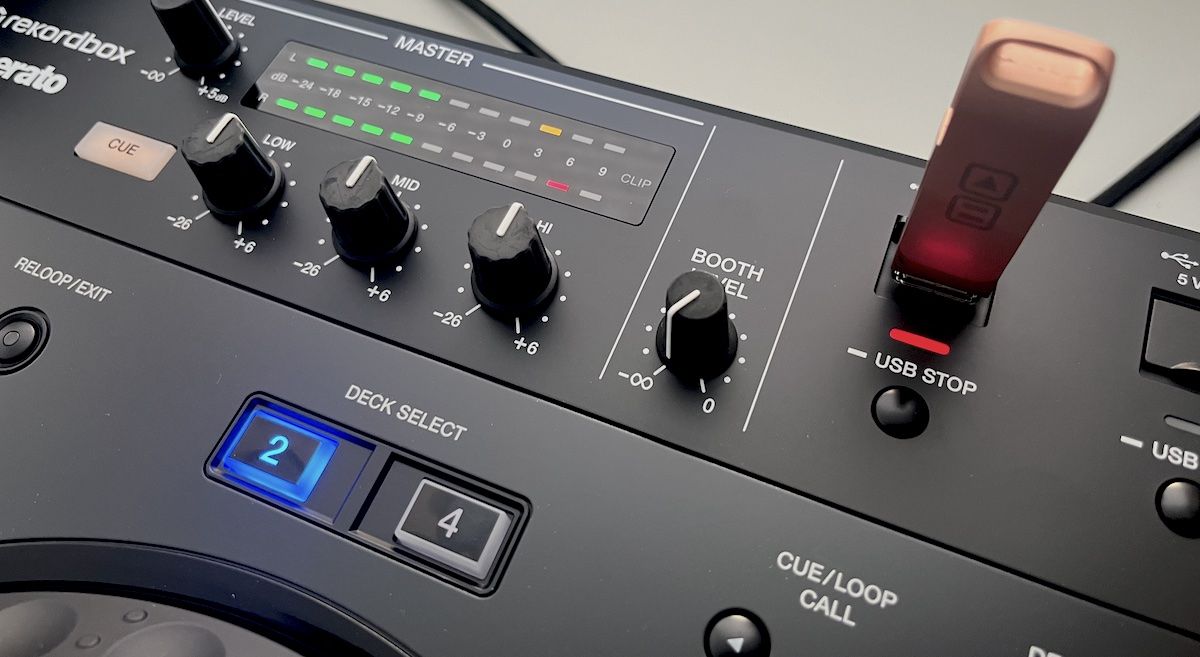
- Master Out EQ/Isolator: this was one of the nicest features on the XDJ-XZ: the ability to control the EQ on the main out. It’s a really quick way to either
- add more performative elements to your mix a la mixing with isolators or
- do a quick-EQing on a basic PA system that needs a little bit of help but there’s no sound guy / mixing desk / actual processing happening beyond your DJ gear.
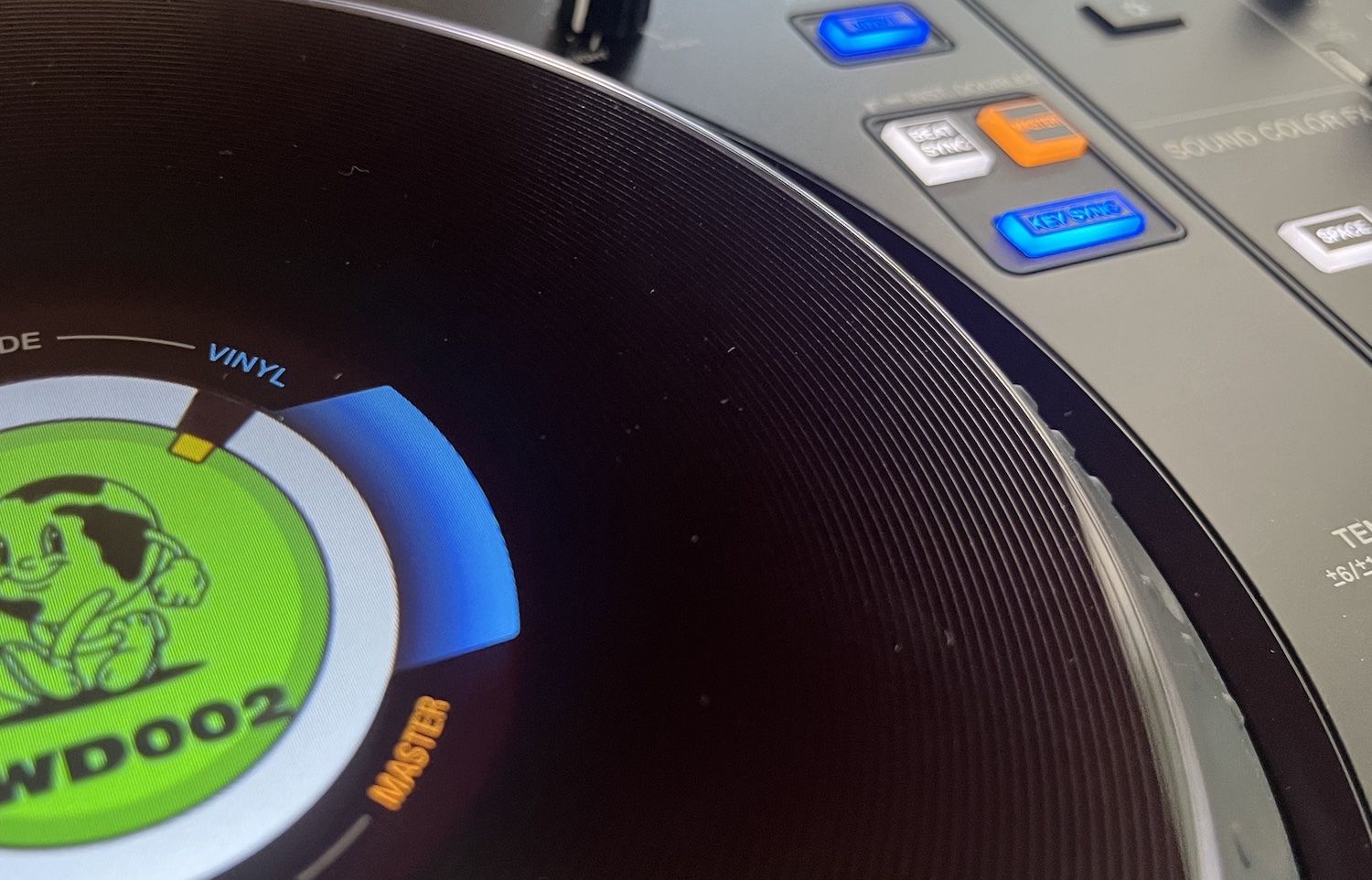
- Those full size jogwheels feel great: with the full-color jog display, these are effectively what you’d get on a CDJ-3000. It has the same tension adjust and mechanical action, meaning that yes, reloads/rewinds feel as they should. One of the challenges that XDJ-R models always have had is their relatively “small-feeling” jogs.
Features I’m Unsure About
I’m still not entirely convinced by two features that Alpha Theta is heavily promoting on this device:
- Cloud Direct Play including Beatport/Beatsource streaming: Music libraries in the cloud a great backup solution for if you forgot your USB, or if you need to take a request. I have yet to encounter a single DJ in the wild (weddings, bars, clubs, festivals, renegades, receptions, graduation parties all included) who was using a streaming library as their primary music source. I think that “being able to play music from whatever source you want” is a great feature, but I don’t see most DJs moving to cloud-only anytime soon – especially because subscription fatigue seems to be at an all time high.
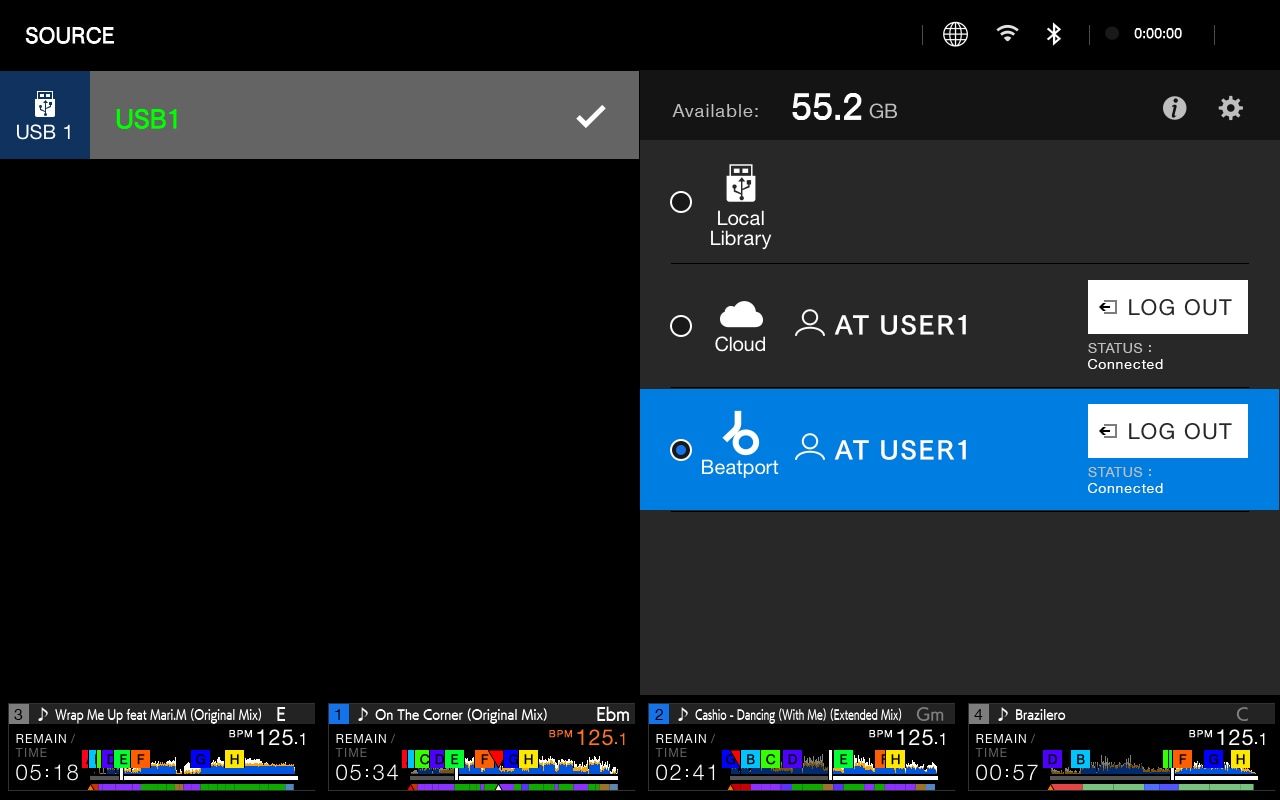
- SonicLink wireless headphone connection: Yes, I’m very happy that there’s a movement towards incorporating low-latency wireless audio into DJ gear. My hope was that it would start with main outputs, not headphones. I’d love to have Soundboks and WaveEight speakers able to connect quickly to a device like this without a dongle. Wireless headphones are nice for some things -but what DJ is going to be more than 3-5 feet away from their decks while they are mixing and wearing headphones?
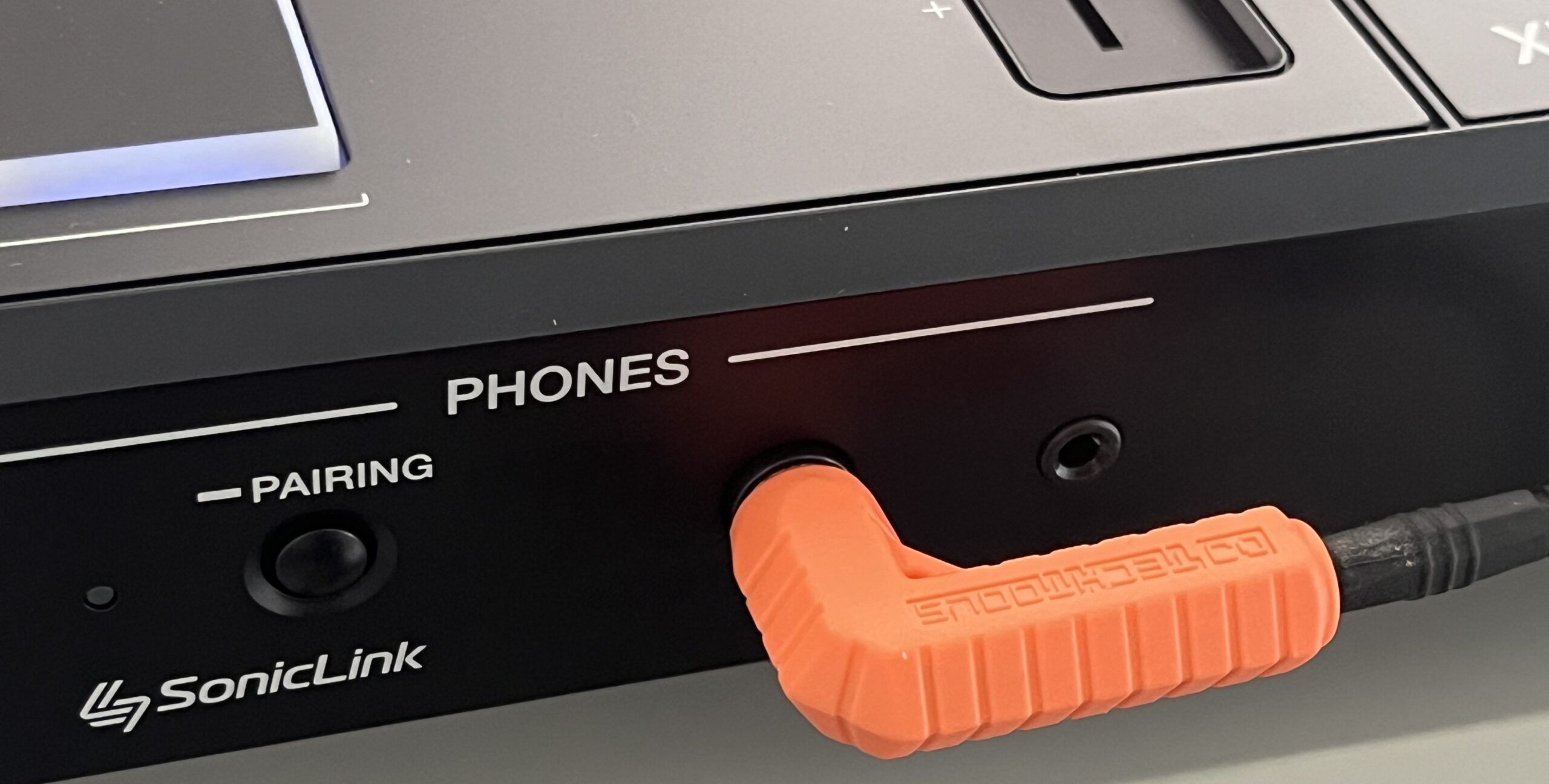
What Needs Improving
- Four deck display: The waveform display needs additional view modes that are optimized for four deck mixing. I imagine this could be very easily added (Denon DJ did a great job of adding tons of additional view modes on their Prime lineup). Right now the view mode for four decks means that you see a “zoomable” waveform of the two decks being controlled currently, and then can only see waveform overviews for the other two. There should absolutely be a mode where the screen shows all four zoomable waveforms concurrently.
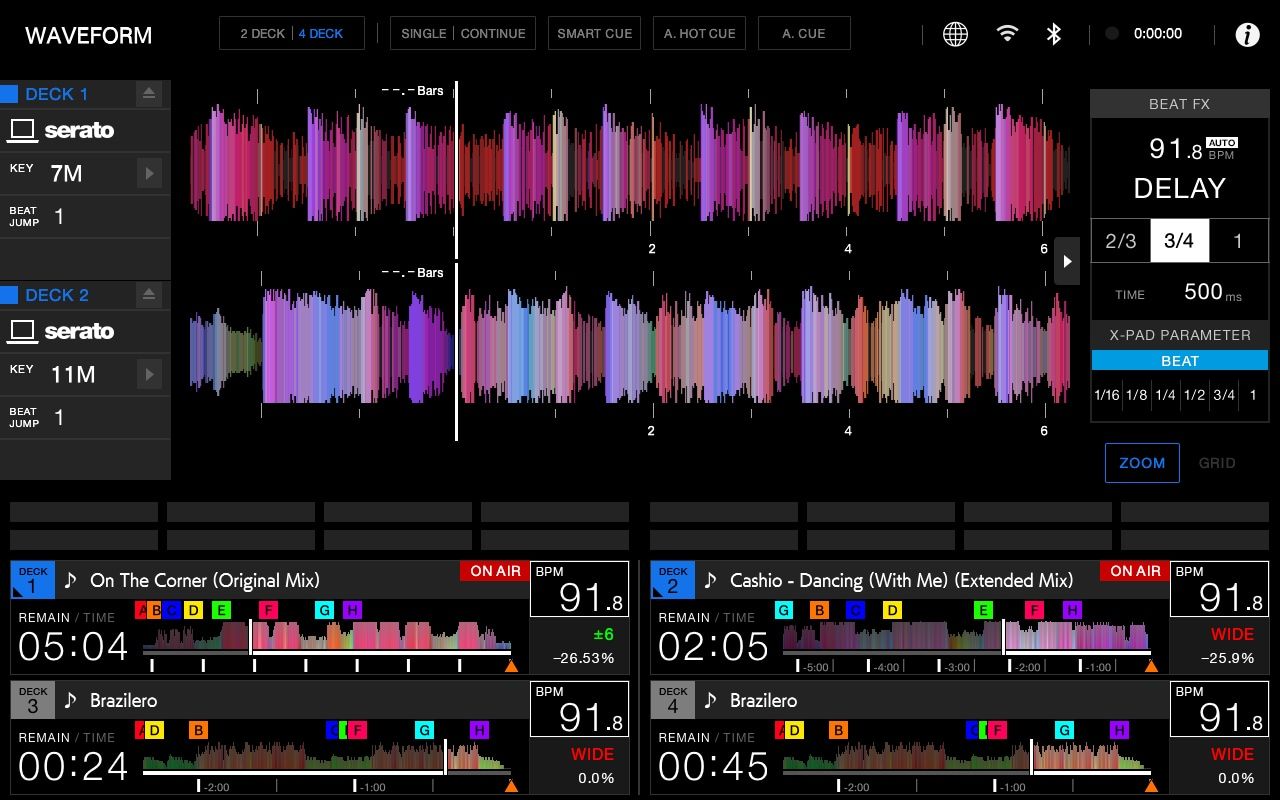
- Extraneous “workflow debt” in the Performance Pads: Product designers at Pioneer DJ, and now Alphatheta, seem to be reluctant to remove features that were added to a product family in the past (ie: memory cues and CDJ mode). Often these features confuse new DJs. It has started to feel like that’s the case with the performance pads on this unit: a remnant of the glory days of the DDJ-SX ten years ago that isn’t good enough to put on the high-end models. Why not put the same cue buttons that are on the CDJ-3000 above the jogwheel on the XDJ-AZ? Or, if cue point juggling on pads is ready for the big league, why not put them on the CDJ-3000? It’s an odd situation.
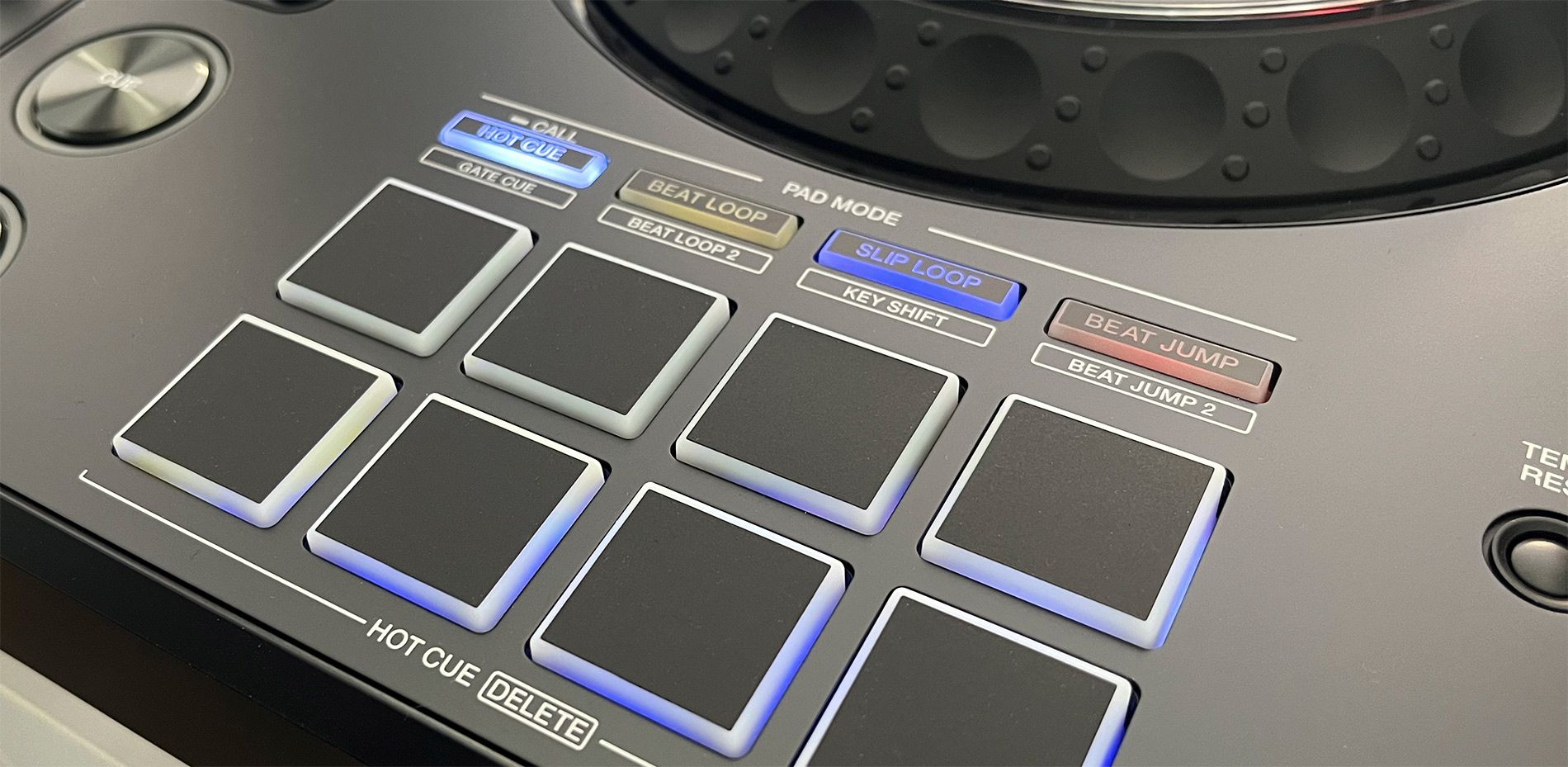
- “Mixer Settings“: Alright, I’m nit picking, but what even is this button doing here, why is the text so big, and why does it occupy so much real estate?
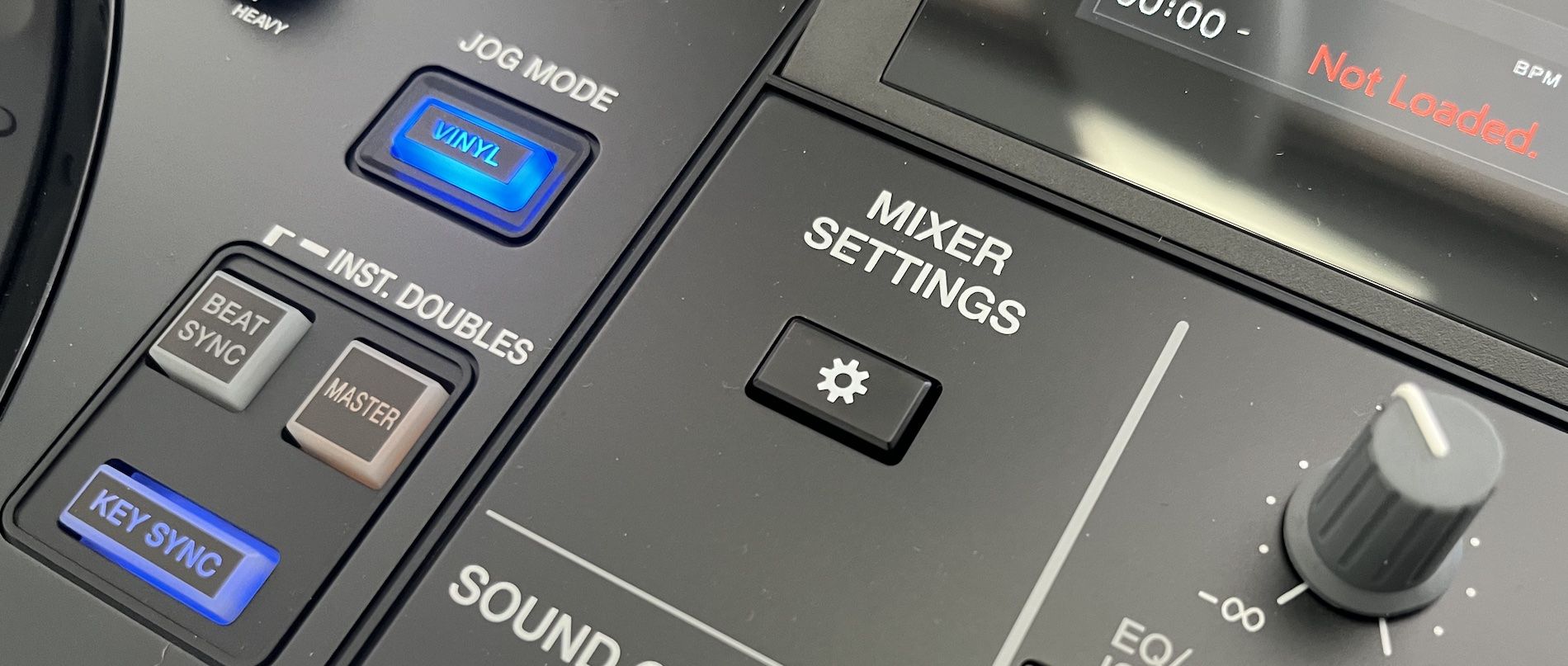
- No Stems Features: This one stings, especially after the release of the DDJ-GRV6 yesterday which has a Rekordbox-based unique stems feature. It seems like this would have been an easy win for Alphatheta to innovate and lead the industry on a high-end model, not just a $829 controller.
That Price Tho
The XDJ-AZ is $3,199 (exactly the same as the Opus Quad’s current price). The reality of DJ gear economics for this device are intriguing. As mentioned when the Opus Quad launched, if the designers at Alphatheta made a unit too similar to four CDJ-3000s and a DJM-A9, they could run the risk of cannibalizing sales of their high-end products. I think that the $3,199 price point here makes “sense” for the business, but still will feel very high to most DJs who aren’t comparing it to the price of a new CDJ/DJM setup.
The other thing that I hope is that that price point is going primarily towards using really good quality materials and components in this device. XDJs get put through a lot (see at a photo of my XDJ-RX below) and product durability over time makes a big difference to users like myself.
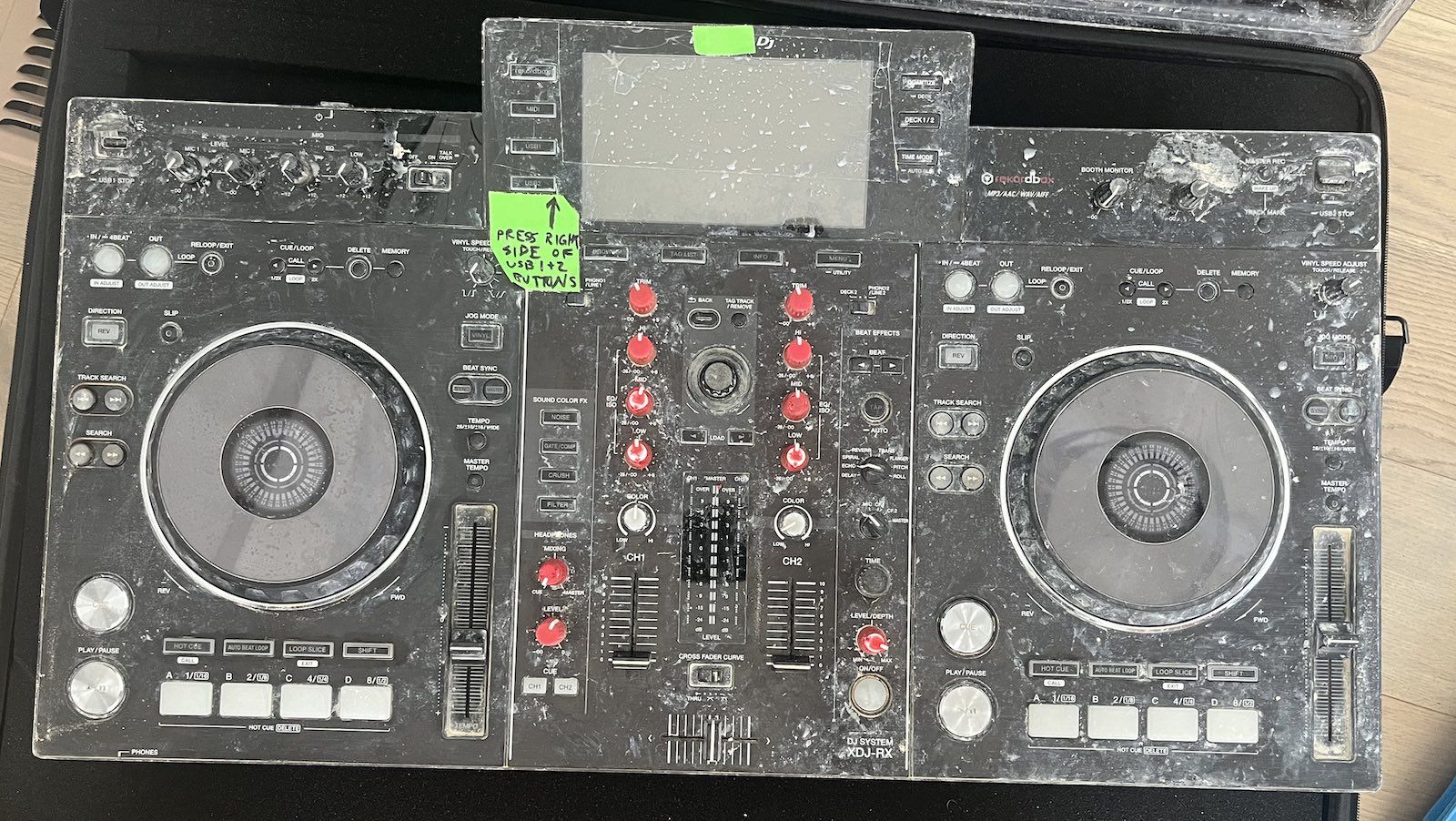
What about the Opus Quad?
Yup, this is a big question. Pioneer DJ released the Opus Quad, their first crack at a four deck all-in-one standalone, in March 2023. There was a bit of a confusing “who is this for?” reaction when it came to the polarizing (people love or hate the retro look) design.
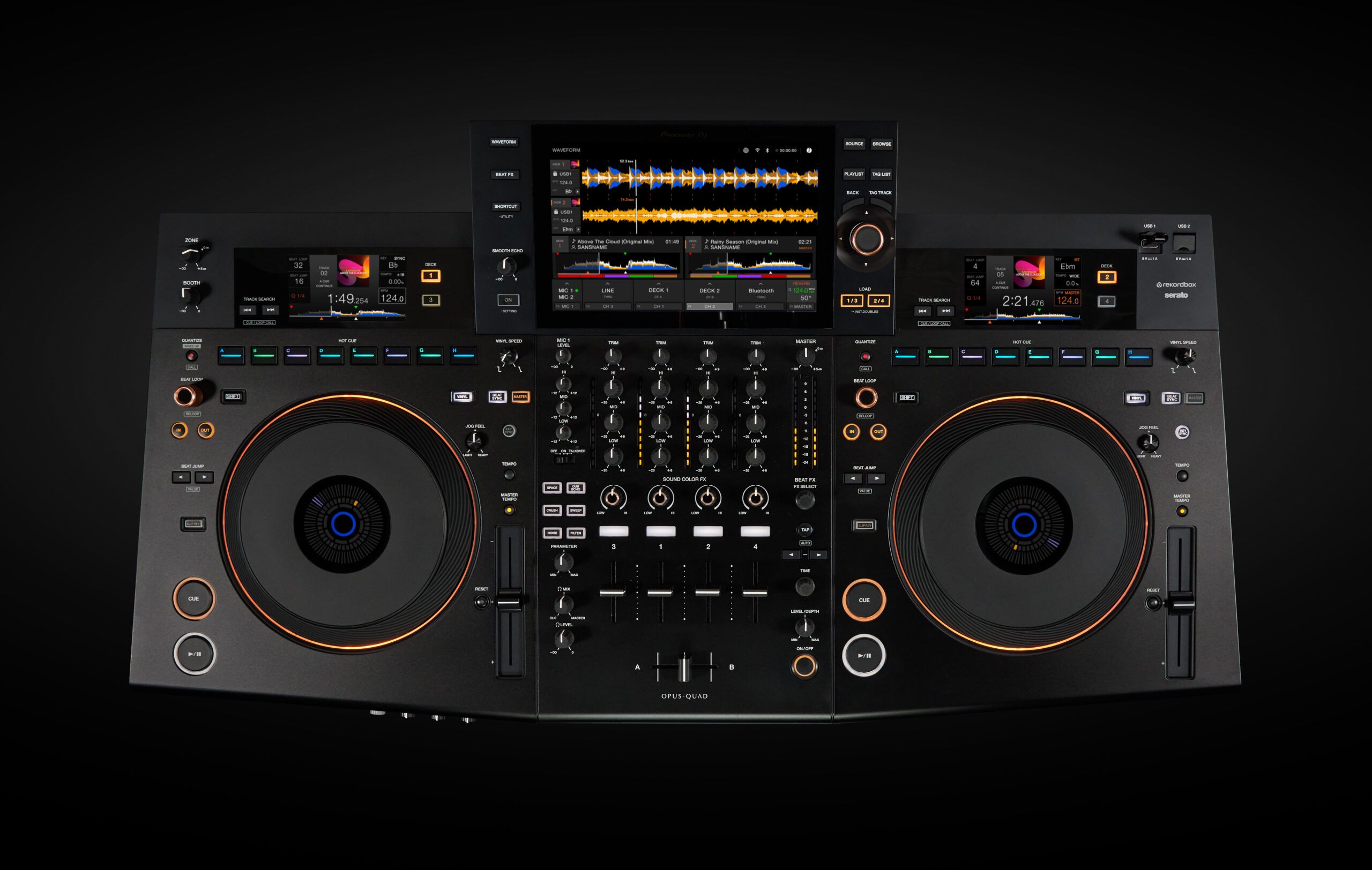
We’ve got a few units in the DJTT store and they’re cool devices, but the layout and workflow isn’t the same as any other device, often deferring to aesthetic decisions than functional ones. It means that DJs who are XDJ/CDJ/DJM familiar have a harder time learning on the fly on these units at a gig. Since that was part of the appeal of the XDJ lineup to start with (familiarity that translates across devices), the Quad has felt more distant of a product release to the core users of Pioneer DJ / Rekordbox systems
A few DJs have remarked to me about how the Opus Quad felt like a lifestyle product (more about how it looks than how it functions) more so than other Pioneer DJ products. Can you imagine taking a really aesthetically-focused product out to be used heavily by other DJs at clubs, renegades, and small parties? Perhaps the XDJ-AZ is the workhorse and the Opus Quad is the pretty pony – but it feels like a splintering of the gear lineup is well underway. Speaking of which, let’s talk about….
A crowded Rekordbox all-in-one landscape
There’s one more thing that is worth mentioning here before I wrap up this writeup: the current state of the standalone market. For Rekordbox users, things have become incredibly saturated. From my vantage point, this saturation started back when the XDJ-RR was released in 2018. The RR felt like a way to make a slightly lower-price product with a slightly different design and fewer features but still doing almost exactly the same thing as the RX2.
Let’s take a quick look at the all-in-one units that a Rekordbox-oriented DJ could consider buying new right now:
- XDJ-AZ ($3,199, four decks, this product)
- Opus Quad ( $3,199, four decks)
- XDJ-XZ ($2,499, two decks but four channels on the mixer, discontinued for the AZ)
- XDJ-RX3 ($2,099, two decks)
- Omnis Duo ($1,499, two decks, battery-powered portable)
- XDJ-RR ($1,049, two decks, from the RX2 generation)
Then, add to that the XDJ-RX2 as still a reasonable buy on the used market for good condition units.
To me, there are a few big issues with the current lineup:
- Everything is too expensive (welcome to 2024, right?)
- There are too many models that do the nearly the same thing
- Models are abandoned too early / don’t get updates / seem to be missing features to create a price point
I hope that Alphatheta will consolidate over the next five years and make fewer models. Should there really be this many all-in-one units, all with their own small differences, components, firmwares, idiosyncrasies, workflows, and user interfaces – from one manufacturer?
The Final Thought: Standalone
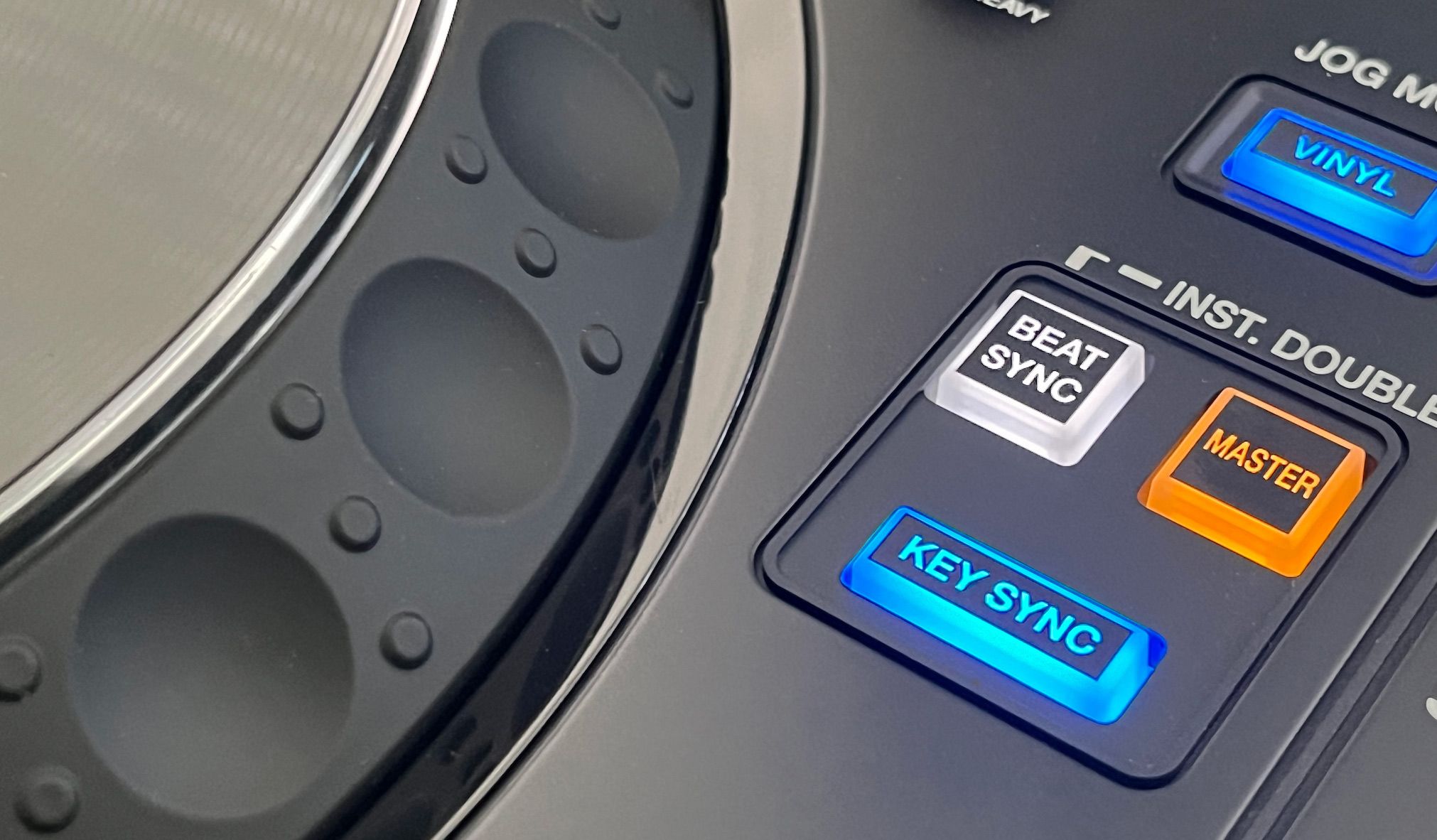
I personally look forward to getting back to mixing four decks on the regular knowing that it will be an option more places with the XDJ-AZ on the market.
So many smaller parties and events have latched onto the XDJ lineup over the last few years, and it has meant that I have thought less regularly about practicing with a third or four deck. Why even bother if I won’t have the option? Most DJs don’t have riders, they’re just playing what is available to them at the gig, or what they brought.
The promise of four deck mixing was clear a decade ago with the controller revolution, Kontrol S4, and DDJ-SX. It’s about time it comes to Rekordbox’s world in way that makes sense.
Get an XDJ-AZ preorder here if you’d like to support DJTT.
Want a better USB drive? We’ve got some news, sign up here to know first.
